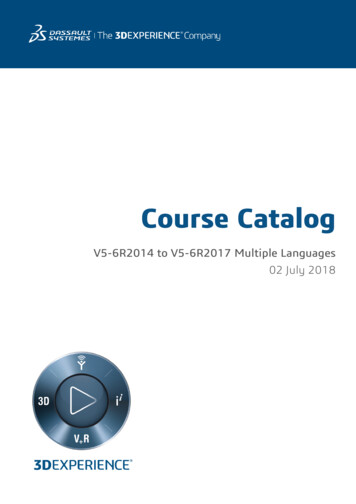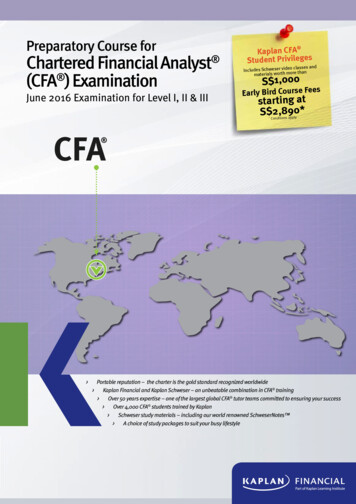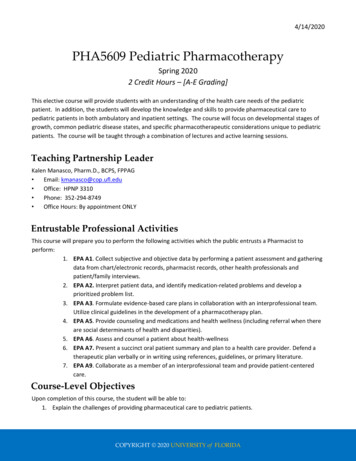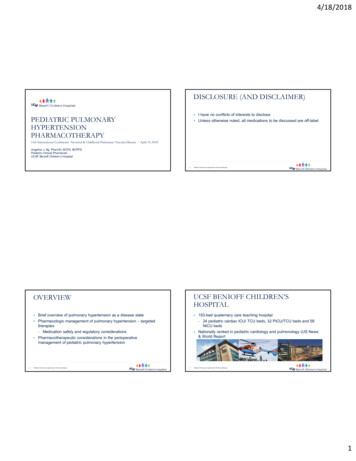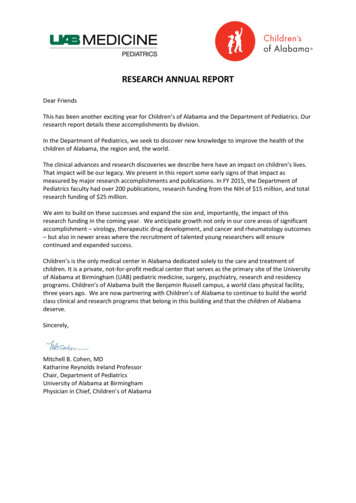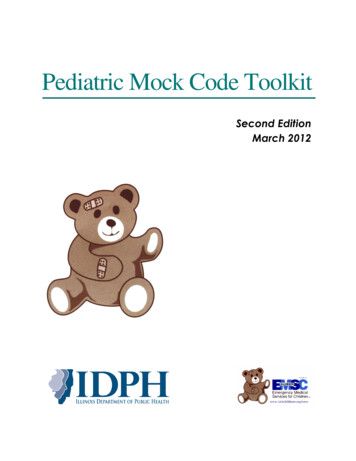
Transcription
Pediatric Mock Code ToolkitSecond EditionMarch 2012
Table of ContentsAcknowledgements . 2Introduction. 3Objectives of Pediatric Mock Codes . 4Aspects of a Pediatric Mock Code Training Program . 4Who should be involved? . 4How often should training occur? . 5What equipment should be included? . 5What are the types of mock code training exercises? . 6How long should the mock codes take? . 6What should be in the discussion/debriefing part? . 6How should the process be evaluated? . 7Implementing a Mock Code Training Program . 8Suggested steps to implementing a mock code training program . 8Barriers and solutions to the implementation process . 9Scenarios . 10What should be included and emphasized in scenarios? . 10What skills should be addressed? . 11Conclusion. 12AppendixA: References . 13B: Sample Mock Code Evaluation & Observer Forms . 14C: Sample Mock Code Survey Forms. 19D: Sample Scenarios . 23E. Additional Forms and Templates . 321
AcknowledgementsIllinois Emergency Medical Services for Children (EMSC) gratefully acknowledges the commitment anddedication of those who helped contribute to the development of this document. Illinois EMSC is acollaborative program between the Illinois Department of Public Health and Ann & Robert H. LurieChildren's Hospital of Chicago. This document was originally developed under the direction of the IllinoisEMSC Advisory Board, Illinois Public Health and Medical Services’ Pediatric Preparedness Work Group,the Illinois EMSC Facility Recognition Committee, and the Illinois EMSC Quality Improvement Subcommittee. Other contributors include hospital Pediatric Quality Coordinators and emergencypreparedness and safety staff. Printing and distribution of this booklet has been supported throughfederal funding from the Assistant Secretary for Preparedness and Response (ASPR) grant.This second edition has been enhanced with additional resources and templates.2
IntroductionIn-hospital pediatric codes have dismal survival rates. Overall, pediatric patients only have a 27% survivalrate to discharge following an in-hospital cardiopulmonary arrest (CPA) and 34% of those who do survivewill have neurological deficits post arrest (1). Ten to sixteen percent of all newborns require some type ofresuscitation assistance at birth (2). The initial actions of the staff that arrive first to the site of a pediatricpatient in CPA or other crisis events are critical. Delays in providing the basic ABCs (airway, breathing,circulation) to pediatric patients lead to poorer outcomes*. If the pediatric CPA or crisis event occurs on anon-critical care unit in the hospital, the initial actions of the staff is even more crucial due to the timedelay in the activation and arrival of a pediatric code team. One study found that the staff nurses in noncritical care units focused more on preparing the room for the code team instead of initiating basic lifesupport (BLS) care and the ABCs for the pediatric patient (3). Since CPA in children occurs moreinfrequently than in adults, medical professionals may have limited contact or experience with unstablepediatric patients. In fact, at one tertiary care teaching hospital, seventy four percent of graduatingpediatricians did not lead any resuscitation events during their residency (4).CPA events elicit anxiety and fear in many health care professionals. Fear of not knowing what to do,where the equipment is and how to use the equipment were listed as the most common fears (5).Breakdowns in communication frequently occur in both mock codes and real resuscitation efforts. Thesedifficulties cause delays and errors in the delivery of life saving interventions. Due to the complexity ofcalculating pediatric medication dosages, medication errors are common.Simulation of pediatric mock codes and other crisis scenarios has demonstrated that there are significantdelays in the ABC steps of resuscitation including application of oxygen, initiation of cardiopulmonaryresuscitation (CPR) and defibrillation (3). These delays are detrimental to pediatric survival rates followingin-hospital CPA. Common required certifications for pediatric health care providers include: basic lifesupport (BLS), pediatric advanced life support (PALS), and neonatal resuscitation program (NRP).Typically these programs require recertification every two years. However, retention of the informationfrom these classes has been shown to deteriorate after only four months. It has been observed that bothphysicians and nurses did not perform CPR correctly as soon as four months following a CPR class (2,6). The literature has shown that lectures and one-time skills stations such as CPR and PALS classes areinadequate to properly prepare clinicians to provide optimal resuscitation efforts (7). Because of this,alternative approaches to training are necessary to maximize patient safety and positive outcomes.Simulation is defined as a “set of techniques to replace or amplify real experiences with plannedimmersive experiences to evoke or replicate substantial aspects of the real world in an interactivefashion” (7). Using pediatric mock code simulation for training has been shown to decrease fears andanxiety related to CPA, improve communication between physician and nurses, and increase theknowledge and familiarity with pediatric resuscitation guidelines which translates directly to improved*The American Heart Association (AHA) 2010 CPR guidelines for pediatric patients recommends following the C-A-B(circulation, airway, breathing) so chest compressions are started sooner. This is for CPR only. The assessment ofthe pediatric patient who does not require CPR still follows the A-B-C (airway, breathing, circulation) sequence.3
performance of resuscitation skills (3, 5). Simulation-based mock codes have been found to correlate withimproved neonatal and pediatric CPA survival rates (8). One study demonstrated a direct correlationbetween survival rates (increased fifty percent) and the increased number of mock code simulationsperformed (8). Simulation training exercises such as mock codes incorporate characteristics common tothe ways adults learn: a more hands on approach to learning and being able to apply what is learned intoreal life (6). Accommodating the adult learners’ needs increases the effectiveness of the educationalexperience which benefits patients through improved quality of care and safety (6). Therefore, it isrecommended that simulation exercises including pediatric mock codes be incorporated into the trainingand education schedule for all facilities.Typically pediatric mock codes are performed in the hospital setting. However, pre-hospital settings,clinics, and physician offices can also benefit from implementing pediatric mock codes into their trainingand education programs. The information in this document can be applied to any clinical setting for anyhealth care professionals.Objectives of Pediatric Mock Codes Improve confidence, comfort level, resuscitation skills, and knowledge of all staff by increasingexposure to pediatric resuscitation guidelines, equipment, and documentation techniques equal totheir level of training and responsibility in a controlled, non-threatening environment.Decrease medication errors.Test the current system to find problems that may not be apparent without mock codes.Provide all staff with updates on current treatment recommendations and best practice standardson a more frequent basis versus the 2-4 year renewal of mandatory courses (e.g., PALS, ENPC,NRP, BLS).Facilitate team building by focusing on better communication and work relationships which aid inavoiding errors and decreasing delays in the delivery of care during resuscitation efforts.Develop the knowledge base and core clinical skills that will assist staff in caring for critically illpediatric patients, especially in times of surge capacity and mass casualty incidents.Aspects of a Pediatric Mock Code Training ProgramImportant components to consider in developing or enhancing a mock code training program include: whoshould be involved in the training, the frequency that it should occur, equipment necessary for thesimulation exercises, the types of training exercises that exist, the length of time the exercise should run,and the importance of the debriefing or discussion afterward.Who should be involved?A multidisciplinary approach to pediatric mock codes is essential. All those involved in an actualCPA event should be included in pediatric mock code training. This provides opportunities toimprove team dynamics and communication, and enhance the ability to work as a team in timesof real emergencies. The Joint Commission identified barriers to effective communication andteamwork such as hierarchy, intimidation, failure to function as a team as contributing factors to4
neonatal deaths during resuscitation efforts (9). Working on these issues in a non-emergent, nonthreatening mock code environment can lead to adjustments without jeopardizing patient safety.At every facility, the make-up of a code team may vary depending on size of the facility, availableresources and staffing. The minimal requirements for a pediatric code team are: a PICU orEmergency Department (ED) physician, an ICU or ED RN (preferably PICU if available), othernursing staff, the nursing supervisor and a respiratory therapist. Below are other possiblemembers of pediatric code teams: pediatric hospitalists, advanced practice providers, pharmacist,residents, anesthesiologist, patient care technicians, other nursing staff, chaplain, languageinterpreters, social workers, security, radiologist, and the nursing manager from the unit wherethe code is occurring. Regardless of the make-up of the code team in each facility, all thoseinvolved in actual pediatric codes should be involved in the mock code training. A moderator orfacilitator is needed to run the mock code and if possible, an observer would also be beneficial toassist in the evaluation process.How often should training occur?There must be a balance between the need to train staff more frequently than the typical annualcompetency trainings and the limitations of time/resources that exist in every facility. Ideally,some type of simulation training should be conducted monthly. This can be a mix of reviewingspecific components of the mock code such as equipment and medications commonly used incodes and full scale mock code events. Performing full mock code events is recommendedquarterly since it has been shown that knowledge deterioration related to the resuscitationprocess begins at four months (2, 7). Mock codes need to occur on all shifts to ensureparticipation by all staff. The mock code training program schedule should include both scheduledand spontaneous trainings to mimic reality.What equipment should be included?Everything that would be used in a real pediatric code is necessary to have in a mock code. Ifresources allow for it, establish an ‘education only’ mock crash cart which is identical to crashcarts used throughout the facility that can be opened and used during the mock codes. Expiredequipment and medications can be stocked in these ‘education only’ carts to simulate a morerealistic experience. If a dedicated ‘education only’ mock code cart is not feasible, utilize a realcode cart to help staff familiarize themselves with where items are kept. Expired medication andsupplies could be used as supplements during the mock code to allow for actual “hands-on”experience.Having the mock code take place in an unoccupied patient room will help familiarize staff with theroom layout and equipment set up (2). Vary the location of the mock codes to include areas inwhich codes occur infrequently (such as the cafeteria, radiology, lobby, etc.) in order to furtherenrich the learning experience.Manikins are available in different sizes with a variety of features. Using the most technologicallyadvanced manikin available (e.g., SimMan or SimBaby ) provides access to advancedcapabilities. However, paper cut-outs or dolls can be just as effective in reaching the objectives ofthe mock code if scenario cues and the environment surrounding the mock code are adequate5
(6). Those hospitals with limited resources may be able to establish partnerships with nursingschools, fire departments, larger hospitals, certified training centers, and other organizations inthe community that may have access to a variety of types of manikins and other resources.What are the types of mock codes training exercises?Full mock codes are recommended whenever possible. Table top drills can be helpful ifequipment to run a mock code is not available, and for rare scenarios that may be difficult tosimulate. Computerized self-training modules are available. Another effective training method isto break down components of resuscitation efforts into monthly educational sessions (which canbe done as a group or independently), ultimately building up to a full-scale mock code.How long should mock codes take?Mock codes should be brief. It has been shown that providers are more likely to get the most outof training exercises when they are short, frequent, and intense lessons with instruction andpractice (6). Twenty minute sessions that include the actual event and debriefing are ideal (2).These short timeframes are also more conducive to conducting mock codes on the unit duringwork time.What should be in the discussion/debriefing session?Each mock code should include a facilitator whose role is to conduct a pre-briefing session,moderate the mock code, and lead the debriefing session. The pre-brief is conducted prior to thestart of the mock code, and provides participants with an overview of simulation, setsexpectations, defines limitations of the environment, and outlines the condition of the mock“patient.” During the mock code, the facilitator provides clinical updates and patient response tothe team’s actions and procedures.Immediately after conducting a mock code, the facilitator leads a debriefing session. The goal ofdebriefing is to allow the participants to integrate behavior change by discussion and selfrealization. Debriefing includes adult learning concepts and follows a three phase process:description, analysis, and application/generalization of learning (10). The description phaseinvolves a discussion of individual and team feelings, and developing a group understanding ofwhat the mock code was about. The analysis phase involves a discussion by the participants ofwhat was effective or ineffective on an individual and group level. The application/generalizationphase completes the process by discussing the lessons learned in the mock code and how thesewill change both individual and group practice/dynamics. If possible, record a video of the mockcode session and replay it during the debriefing session. This has been shown to be valuable forobserving and critically analyzing the team’s performance by both the participants themselvesand the moderators of the exercise (11). See a companion PowerPoint presentation entitled,“Create Your Pediatric Mock Code Program” on the Illinois EMSC Web site.The facilitator also provides performance feedback (if this has not been addressed during thedebriefing). This feedback, especially related to the performance of the basic ABCs, is essentialto the participants’ learning experiences (6). Reviewing positive aspects of the performance aswell as identifying areas of improvement is important. Allowing participants to ask questions aboutevents that occurred during the mock code is another aspect vital to the learning experience.6
Another learning technique is “Repetitive Pediatric Simulation” which allows participants to refinetheir resuscitation behaviors and apply newly acquired knowledge which then leads to a moresolid learning experience (4). Immediately following the debriefing session, the participants wouldrun through the mock code again giving them the opportunity to reinforce what was doneappropriately, as well as address any performance, communication, or team errors.How should the process be evaluated?Survey participants and moderatorsoAssess how effective the participants feel the mock code training was in meeting theobjectives and their educational needs. There are many varieties of surveys andevaluation forms that are available or can be designed to accomplish this task. Utilizeinformation from both the survey and the evaluation tool from the mock code to monitorquality improvement and identify educational needs. See Appendix C for examples.Evaluation tooloChecklists are important tools for observers and facilitators to utilize during pediatricmock code training exercises. They provide a record keeping method to document skillassessment during the mock code. Information from a checklist provides an opportunityto give concrete feedback to the participants to aid in their learning experience; providesguidance and recommendations for any educational needs that may be necessary toaddress if deficiencies in the standards of care are discovered; provides an opportunity toidentify processes that need improvement; and can serve as both patient safety andquality improvement indicators. There are many varieties of tools that exist and can beadapted to fit the goals and objectives of each individual facility. Tools can range from asimple list of objectives and skills that are then evaluated by an “achieve/did not achieve”format to more complex scoring methods. For example, the Lucile Packard Children’sHospital Mock Code Score Report uses a point system based on the time to completeeach intervention (12). One advantage of using a more complex scoring tool is that itprovides a more concrete and detailed way to compare and evaluate the interventionscompleted during the mock code, as well as provides a tool for quality improvement toevaluate the effectiveness of the mock code training program (13). For example, knowingthat it took staff three minutes to provide necessary oxygen during the resuscitation effortgives a greater understanding of potential learning needs. As a result, this can identify, inmore detail, educational issues that need to be addressed. One disadvantage of using amore complex scoring system is that the mock code may be interpreted as a test insteadof a non-threatening learning experience. Also, an additional person would be needed to‘keep score’ during the pediatric mock code. See Appendix B for examples of differenttypes of evaluation tools.oMock code results should always be kept anonymous to preserve the safety of thepractice environment and be reported in the aggregate.7
Implementing a Mock Code Training ProgramSuggested steps to implementing a mock code training programoGain administrative support. Having administrative support is crucial for a successfultraining program. Leadership can assist with budget/resource needs, participation, staffcompliance and quality improvement within the pediatric mock code program.oForm a planning committee. A multidisciplinary group should be convened to provideguidance and direction in the development of the pediatric mock code program. Minimallyinclude nursing, physician, and education representatives. Other key representatives toconsider on the planning committee are respiratory therapy and pharmacy. At the veryleast, these additional representatives should be consulted during the developmentprocess. Also involve advanced practice providers if they are utilized. Forming a separateplanning committee specific to pediatric mock codes may not be feasible at somehospitals due to staffing concerns and time commitments. Therefore, utilizing an existingcommittee such as a Hospital Code Blue Committee or Quality Improvement Committeeis an option, as long as the key players, especially from administration, are involved andthere is a pediatric focus.oPerform a needs assessment. A needs assessment can be helpful in identifying thefollowing key information: the comfort level of staff with caring for severely ill and injuredchildren; staff experience with pediatric codes; suggested topics for mock codescenarios; and the preferred time to hold a pediatric mock code. The needs assessmentshould be conducted on a regular basis to assist with evaluating the effectiveness of thepediatric mock code program, and identifying opportunities for improvement. SeeAppendix E for a sample pediatric mock code needs assessment.oUpdate staff. During physician and nursing staff meetings, provide progress updates onthe program planning, expectations of the participants, and benefits of the program.These meeting updates will increase awareness and garner their support and interest inparticipating in mock codes. As mock codes are conducted, continue to update staff inorder to educate those who were not able to participate regarding lessons learned duringthe mock codes.oDevelop mock code scenarios. See Appendix D for sample scenarios and Appendix E forscenario worksheets.oSchedule date/times for mock codes. If performing a scheduled mock code, inform allinvolved disciplines of the date/time. If performing a spontaneous mock code, restrictschedule information to only the facilitators and other key individuals. When conducting aseries of educational training sessions that focus on code components, map out theschedule on a month-by-month basis. Also schedule the date/time in which the full-scalemock code will be conducted. This helps staff to build on their core clinical skills andready themselves for the all-inclusive mock code.8
oComplete pre-mock code preparations. Assign who will be responsible for setting up thearea and ensuring all equipment is functioning and available. In addition to checkingequipment, ensure one of the committee members reviews the dosage chart aids foraccuracy and consistency with current standards. It is also beneficial to run a pilot mockcode with those on the planning committee to identify any issues/challenges that existbefore bringing the process to the staff. Also, assign a person who will be responsible forrestocking the code cart after the mock code is completed. See Appendix E for samplemock code planning tools.oEnsure all members of the multidisciplinary team respond to the mock code. Encouragenurse managers to free up staff as much as possible and encourage physicians,advanced practice providers, and other disciplines to attend.oRun the mock code as realistically as possible so staff members: respond to the codecall; perform interventions on the manikin as required by the scenario; participate in thepost-code debriefing session; and complete a survey and evaluation form. Ensure staffrotates into all possible roles that they may be responsible for during a real pediatricevent so they do not always perform the same role that they are most comfortable with.oHave the committee analyze the event and make adjustments as needed for futuretraining exercises.Appendix E contains forms that can assist in organizing the steps needed to develop a pediatricmock code program, including a Pediatric Mock Code Program Planner, a Pediatric Mock CodeResource Checklist, and a Pediatric Mock Code Scenario Worksheet.Barriers and solutions to the implementation processoBarrier: Funding and staffing issues, especially in smaller hospitals (i.e., Critical AccessHospitals) can influence whether or not mock codes are part of the education curriculum.Solution: Schedule mock codes during shift hours to avoid overtime. Compliance fromnurses may also increase if done during scheduled work hours instead of having to comein on a day off. Utilize available community resources for training supplies such asmanikins (i.e., local fire departments, nursing schools, AHA-certified training centers,other hospitals in the area). Break down the components of mock codes into monthlyself-learning training exercises that staff can do independently. These componentsshould be specific to the roles each discipline plays during the code process. Also, bylimiting the pediatric mock code to the recommended twenty minutes, it is reasonable toschedule it without the need for increased staffing.oBarrier: Perception that pediatric mock codes are not a priority due to low volume ofpediatric patients seen at a facility.Solution: Studies on neonatal resuscitation have shown that there is a higher infantmortality rate in hospitals that have a low volume of deliveries compared to hospitals witha high volume of deliveries (14). Contributing factors for this disparity in outcomes are9
likely related to staffing issues and a lack of preparedness (14). Therefore, pediatric mockcodes should be a priority in all facilities, regardless of the volume of pediatric patientsseen at the facility. Even if a facility does not have inpatient pediatric services, they maylikely have outpatient services that treat children. In addition, children may be visitors andhave the need for emergent care.oBarrier: There is not a strong and supportive physician-nurse relationship at the facility.Solution: Having administrative support for a mock code training program is key andcan increase compliance. Performing mock codes has been shown to improvecommunication and teamwork, which translates directly into improved patient care (2).oBarrier: There is resistance to change and the belief that experienced health careproviders have nothing further to learn from participating in mock codes.Solution: It has been demonstrated that even the most experienced clinicians neglect toperform essential resuscitation interventions. Therefore, all clinicians, regardless of howfrequently they are involved in real life resuscitations, can benefit from mock codes (6).Encourage participation by all providers in mock codes and provide detailed suggestionsafter the event on opportunities for improvement. Sharing current literature detailingalarming deficits that occur during a simulation of a pediatric code with even the mostexperienced clinicians, and recommendations from professional organizations related tothe need for mock codes may also help.oBarrier: Latent conditions, such as physical infrastructure, adequacy of training,organizational culture (including managerial and employee beliefs), and hiddenworkplace factors can present barriers to communication and teamwork. These barriershave negative and potentially detrimental effects on resuscitation efforts (15).Solution: Educate administration on how often systems errors occur duringresuscitation efforts and how simulation training through mock codes can be effective.The Agency for Healthcare Research and Quality (AHRQ) published a guide called “WillIt Work Here? A Decisionmaker’s Guide to Adopting Innovations” that may be a usefulreference in adopting new programs or making changes to existing programs (16).ScenariosWhat should be included and emphasized in scenarios?Scenarios should be brief, realistic, and the details of the scenario story line planned ahead oftime. Scenarios should address all ages of the pediatric population. Each individual hospital,clinic, or agency should follow the age range they have defined for pediatrics (Illinois EMSCdefines the pediatric patient as age 0 to 15 years). Vary and rotate scenarios so they do notbecome predictable to the staff. Lastly, scenarios should be appropriate for the clinical area themock code is occurring in (6).Incorporate three aspects of learning into every scenario: cognitive (knowledge), behavioral (howto react to situations), and psychomotor (skills, ability) (2). Difficult and possibly controversial10
issues that may take place during actual resuscitation efforts within each unit or facility should
delays in the ABC steps of resuscitation including application of oxygen, initiation of cardiopulmonary resuscitation (CPR) and defibrillation (3). These delays are detrimental to pediatric survival rates following in-hospital CPA. Common required certification

